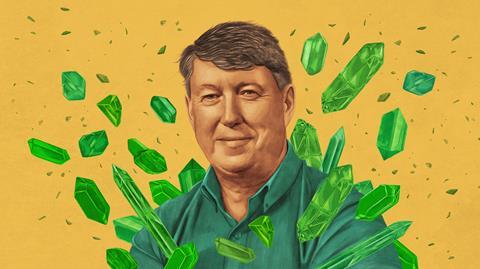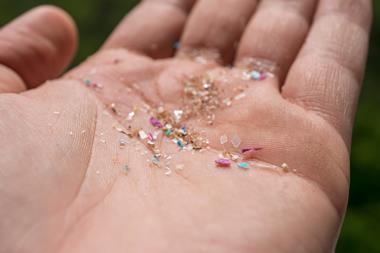The father of green chemistry on his love of the environment, striving for unattainable perfection and breathing life into an old town library

Paul Anastas is the Teresa and H. John Heinz III professor in the practice of chemistry for the environment and director of the Center for Green Chemistry and Green Engineering at Yale University in the US. He has also served as the assistant administrator for the US Environmental Protection Agency and director of the ACS Green Chemistry Institute in Washington, D.C. Between 1999-2004, he was assistant director for the environment in the White House Office of Science and Technology Policy. In 2021, Anastas was awarded the 2021 Volvo Environment Prize in recognition of the transformative impact of his work across numerous sectors and industries. He was speaking with Julia Robinson.
Paul Anastas is the Teresa and H. John Heinz III professor in the practice of chemistry for the environment and director of the Center for Green Chemistry and Green Engineering at Yale University in the US. He has also served as the assistant administrator for the US Environmental Protection Agency and director of the ACS Green Chemistry Institute in Washington, D.C.
I knew at a very young age that I cared a lot about the environment. Our family home overlooked a beautiful, pristine salt marsh that was alive with all kinds of things. Now, the salt marsh is gone; the bulldozers drove in when I was about eight years old and now there’s nothing there but glass banks and insurance companies.
The time when chemistry first got me was when, during a reaction, I saw beautiful crystals precipitating out of solution and I knew that those crystals were something the world had never seen before. The idea that a person could make new things and introduce them into the world just felt so fundamentally powerful to me – I wanted to explore all the good that might be done with that.
In graduate school, my chemistry was focused on a lot of anti-cancer research. I had a very nice postdoc lined up at Harvard Medical School but as I was completing my PhD, some people very close to me got terminal cancer. I couldn’t reconcile the fact that I was doing all this work and I couldn’t do anything to help the people that I loved the most.
A person at the Environmental Protection Agency offered me a job. He said, ‘If I give you a job with a big staff and a big budget, what are you going to do?’ And I said, ‘instead of trying to make molecules that can treat or hopefully cure cancer, I want to make it so that all of our molecules can never cause cancer or other toxic effects’. I was 26 years old, and two years later, I had defined the field of green chemistry and launched the US Green Chemistry programme.
I’m proudest of being part of a global green chemistry community. While I get a lot of recognition for ‘my’ achievements, I really think that the biggest achievements are the actions that are being taken by this growing, magnificent global green chemistry community.
I’m impatient – a sworn enemy of the status quo. The work of the green chemistry community is important and it’s urgent. Whether it’s on toxicity or climate change, or microplastics, PFAS or endocrine disruptors, these are urgent and important challenges. So, I don’t like inertia.
We need to do better to harness our brilliance and creativity as a field of chemistry – a field of inventors and discovers and innovators – and harness it to make a sustainable world.
Our biggest challenge is [also] our biggest opportunity. The last 200 years were reductionism – the age of the analyst. What we’re ushering in today is the age of the synthesist, who understands, and can build those interconnections, but can do it in ways that are conducive to life and compatible with the world around it.
Your real audience will not be born for years to come
You build a community by catching people doing things right. Green chemistry has the goal of perfection knowing that we’re never going to attain it – that’s the only way to preserve continuous improvement. None of us are going to achieve perfection, but we must have a genuine desire to move toward that.
A while back, the old town library down the street from me was put up for sale. Long story short, I now own it. In many ways, for working, that’s my happy place. I also open it up for events – we have everything from book readings, a whole conference of women storytellers, and even weddings – but most of the time it’s just me, I enjoy writing and thinking there.
I make a point of being certain of almost nothing but one thing that I am certain about is that we can’t keep doing things the way we’re doing them, and that means that change is essential.
Thirty years ago there was a genuine question to be asked; can chemistry develop the new materials, synthetic methodologies, transformations and manufacturing processes to be truly sustainable – to move from being depleting to being renewable, from degrading to restorative, from toxic to helpful? That question has been answered, and the answer is an emphatic ‘yes’. Now the question is, will we implement these new approaches at a scale and time frame that’s necessary to meet our challenges?
I’m extremely hopeful and optimistic – maybe that helps me get out of bed in the morning – but I often tell younger students, as much as you respect your mentor, your professor, your advisor, your scientific hero – that is not your audience. Your real audience will not be born for years to come.
We need to have new ways of thinking. We need innovation in our business models, our investment platforms, our approaches to policy. The idea of putting reactive, slow and ineffective policy bandages on fundamentally unsustainable products, processes and systems, makes no sense. I spent a lot of time in Washington DC and have a lot of experience in the policy world – we need innovation there to couple with the scientific and technological innovations that have been taking place.
More than anything else, I just want to spend as much joyful time with my daughters and my wife. If there’s one thing that I realised long ago, and thank goodness I did, is that time passes quickly and that the longest life is too short. Every interaction, every conversation, every experience, every little bit that we travel, every new thing that we see – that is what gives me joy.
At one time I was a reasonably good trumpet player but now I only play for myself and my daughters. But I do love writing music. I wrote a lot of songs when the girls were little – more for their laughter and entertainment – and I’ve continued writing more thoughtful songs as they’ve grown.

















No comments yet